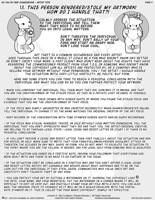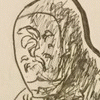
Do You Do "Free Commissions" Artist Page 2
CLIENTS: Page 1 - Page 2 - Page 3
ARTISTS: Page 1 - Page 2 - Page 3 - Page 4
5. Calculate the total sum of their commission using your base price sheet. If there are Any extra fees you need to add, such as extra character details, canvas size, etc, explain why. Don't try to cheat your client by adding UNNECESSARY hidden amounts.
When adding up the price, you want to tell the client what you are adding to get the total amount. For example, I always tell the client how much the commission will cost and if it is a high amount, I show what I'm adding, this includes as number of characters, the base price of the commission, the add-on's etc. Showing the client why the amount is so high is easier for them to understand instead of just slapping them with a large amount, saying “This is the price. Pay up”. After you show them the price, ask if they agree before they pay because what you offer might be a bit too much for them or they wish to question why the price is so high.
6. When sending them an invoice, always include the amount you both agreed on for the commission, the correct currency, the client's name, and a fair time period for sending payment ( ideally 7 days ). The last thing you want is to have your payment service provider flagged and report you for a wrongful transaction.
Most artists use PayPal for their business. Here is an example of a PayPal invoice layout. Make sure that you have the correct email address the client uses for their PayPal account. It is ideal to put the Due Date for 10 days. This gives the client time to get the finances he needs to pay so they don't feel rushed doing so. Enter the client's name. It could just be their first name, last name, furry name, or twitter name. In the next like, put the commission description. Make sure that the total amount is equal to the amount and currency that the client agreed too. It also doesn't hurt to check the ADD TIP option, just in case the client is feeling generous. If the client wants to pay half now and half later, mark the partial payment option. In the NOTE TO RECIPIENT, make sure to write what this invoice is for. In the TERMS AND CONDITIONS, ALWAYS put a link to your TOS. Just in case the client wishes to flag you for a “wrongful transaction”, PayPal can look at the invoice and see the TOS the client agreed to when paying.
7. Artistic Freedom means you can incorporate your own personal insight and creativity with the commission you are hired to create, as long as it still follows the client's character details and the general commission idea.
Artistic freedom can be scary for some artists. Some artists need a direction for the character, such as a setting, behavior of the character, likes and dislikes, etc. When a client is telling you that you have Artistic Freedom, they are telling you to use your own imagination for the piece and they trust you on that. You don't want to draw something that might offend the client at the end. If you wish to ask for more insight on what to draw from the client, ask. Your tastes may differ from the client's.
8. When you receive full payment for a commission job, you should make it your goal to have the client wait as little time as possible for a finished and polished product ( depending on how big and complex it is ). A quick turn around time means a happy and returning client as well as a good business reputation. Don't rush.
For me, my turn around time is between 30 to 60 days. I don't want the client to wait long for their commission. Most times, the client gets their commission within a week or two from payment, either because it was a simple commission, or they were high on my queue. If a commission will take longer than 60 days, I will tell the client way before the due date to let them now that it will be late. Good artists inform their paid clients that there will be delays to their paid commission due to life hick ups and factors out of their control.
You don't need to go deep into your personal life about what is happening. Just the basics and that their commission might be late. Also, as an option to the client, give them the option for a refund. Some clients don't like to wait long for their commission. Offering this means that you are a kind and trustworthy artist and that you respect the client. Even if they reply saying they don't mind waiting, as long as you send them updates, everything should be fine. Don't be one of those artists who take the money and runs or have the client wait a year for their commission because you “forgot” or your “hamster died and it will take you a year to grieve.” I'm not joking as an artists used this excuse to push the commission for a later date. )
artwork © Alex Cockburn ( Ookami Kemono ). All Rights Reserved.
ARTISTS: Page 1 - Page 2 - Page 3 - Page 4
5. Calculate the total sum of their commission using your base price sheet. If there are Any extra fees you need to add, such as extra character details, canvas size, etc, explain why. Don't try to cheat your client by adding UNNECESSARY hidden amounts.
When adding up the price, you want to tell the client what you are adding to get the total amount. For example, I always tell the client how much the commission will cost and if it is a high amount, I show what I'm adding, this includes as number of characters, the base price of the commission, the add-on's etc. Showing the client why the amount is so high is easier for them to understand instead of just slapping them with a large amount, saying “This is the price. Pay up”. After you show them the price, ask if they agree before they pay because what you offer might be a bit too much for them or they wish to question why the price is so high.
6. When sending them an invoice, always include the amount you both agreed on for the commission, the correct currency, the client's name, and a fair time period for sending payment ( ideally 7 days ). The last thing you want is to have your payment service provider flagged and report you for a wrongful transaction.
Most artists use PayPal for their business. Here is an example of a PayPal invoice layout. Make sure that you have the correct email address the client uses for their PayPal account. It is ideal to put the Due Date for 10 days. This gives the client time to get the finances he needs to pay so they don't feel rushed doing so. Enter the client's name. It could just be their first name, last name, furry name, or twitter name. In the next like, put the commission description. Make sure that the total amount is equal to the amount and currency that the client agreed too. It also doesn't hurt to check the ADD TIP option, just in case the client is feeling generous. If the client wants to pay half now and half later, mark the partial payment option. In the NOTE TO RECIPIENT, make sure to write what this invoice is for. In the TERMS AND CONDITIONS, ALWAYS put a link to your TOS. Just in case the client wishes to flag you for a “wrongful transaction”, PayPal can look at the invoice and see the TOS the client agreed to when paying.
7. Artistic Freedom means you can incorporate your own personal insight and creativity with the commission you are hired to create, as long as it still follows the client's character details and the general commission idea.
Artistic freedom can be scary for some artists. Some artists need a direction for the character, such as a setting, behavior of the character, likes and dislikes, etc. When a client is telling you that you have Artistic Freedom, they are telling you to use your own imagination for the piece and they trust you on that. You don't want to draw something that might offend the client at the end. If you wish to ask for more insight on what to draw from the client, ask. Your tastes may differ from the client's.
8. When you receive full payment for a commission job, you should make it your goal to have the client wait as little time as possible for a finished and polished product ( depending on how big and complex it is ). A quick turn around time means a happy and returning client as well as a good business reputation. Don't rush.
For me, my turn around time is between 30 to 60 days. I don't want the client to wait long for their commission. Most times, the client gets their commission within a week or two from payment, either because it was a simple commission, or they were high on my queue. If a commission will take longer than 60 days, I will tell the client way before the due date to let them now that it will be late. Good artists inform their paid clients that there will be delays to their paid commission due to life hick ups and factors out of their control.
You don't need to go deep into your personal life about what is happening. Just the basics and that their commission might be late. Also, as an option to the client, give them the option for a refund. Some clients don't like to wait long for their commission. Offering this means that you are a kind and trustworthy artist and that you respect the client. Even if they reply saying they don't mind waiting, as long as you send them updates, everything should be fine. Don't be one of those artists who take the money and runs or have the client wait a year for their commission because you “forgot” or your “hamster died and it will take you a year to grieve.” I'm not joking as an artists used this excuse to push the commission for a later date. )
artwork © Alex Cockburn ( Ookami Kemono ). All Rights Reserved.
Category All / All
Species Unspecified / Any
Size 842 x 1089px
File Size 540.2 kB
Listed in Folders
It is fun to have artistic freedom over a commission. You get to put in your own take on who/what the character is and, if the client loves it, will incorporate that idea into future work or even into the character's background. The artist has a chance to permanently mold the character in a way that the client never seen before.
Question about #7. If a client hires you to do an artistic freedom piece with some description of their character's personality, etc, but they end up not liking the rough sketch at all - what do you do after that? Do you charge an additional fee for the work you've already done and start a new sketch? I would love to hear your thoughts on a situation like that please.
I've had this happen before many times. There were a few clients who were very vague on what they wanted, but told me I had "artist freedom" to fill in the gaps. When I showed them the sketch, they didn't quite agree with the direction or the pose or concept. After that, they basically told me their entire idea, which is a very far turn from what I sketched, even the thumbnails I showed them. Some blamed me for not getting their vague idea right when they offered me nothing about the idea they had in mind. All my sketches are traditional, so it takes time for me to draw something on paper for them and can't be easily edited like on a computer. A lot of erasing and redrawing have to be done over and over again. I told them that I needed more information on their idea and what they had in mind didn't fit with the "artistic freedom" they granted from me. If they wanted something completely different and me to start over from scratch, I would redo it, but I would tell them that I might use the failed sketch as a YCH image because I personally like it. If they wanted several revisions, I tell them that they would have to pay a small percentage of the total price of the commission they hired me to do because they failed to provide all the information to be before I started to work.
Some clients use the "artistic freedom" to fill in the gaps of their ideas because they don't know how to explain it or describe it. This can be frustrating and time consuming. Its always best to know exactly what you want the artist to draw. If you have a simple idea of your character eating ice creame and you give the artist artistic freedom to draw your character eating ice creame, expect to see an image of your character eating ice creame. If you expect your character to be eating ice creame while "shooting lasers at robots that are falling from the sky and the character is on Mars with several tentacles wrapping around them and there is a futuristic city burning in the background, oh and the character is naked as well", but all you got was a character eating ice creame, then you missed some important information there and you should be responsible for not giving the artist your ENTIRE description on what you want for the image.
Some clients use the "artistic freedom" to fill in the gaps of their ideas because they don't know how to explain it or describe it. This can be frustrating and time consuming. Its always best to know exactly what you want the artist to draw. If you have a simple idea of your character eating ice creame and you give the artist artistic freedom to draw your character eating ice creame, expect to see an image of your character eating ice creame. If you expect your character to be eating ice creame while "shooting lasers at robots that are falling from the sky and the character is on Mars with several tentacles wrapping around them and there is a futuristic city burning in the background, oh and the character is naked as well", but all you got was a character eating ice creame, then you missed some important information there and you should be responsible for not giving the artist your ENTIRE description on what you want for the image.
Ok this has helped a lot! I work traditionally as well and have used past scrapped ideas as YCH to salvage the sketch as I too liked it. I like the idea of charging a small percentage if I need to start completely from scratch. You second paragraph was pretty great by the way. I really appreciate you taking the time to offer your insight and thoughts on my questions - means a lot! Cheers to you.
oh yeah, #5. Be clear on the price before starting to paint. Plan out the piece in your head (or list the steps out on paper). If you're not sure if, say, feathers take a long time or not, ask the commissioner a. how much do they care about the details of the feathers and b. whether you can charge more for that. Don't just tag on at the end "well, feathers took a long time so..."
(seen it happen, never had it happen to me)
6. Yes, clarity on that time period. And do keep in constant communication. If they tell you, for example, the bank rejected their payment and it'll take two more days, give them the two more days (or vice-versa, if they tell you to check if you received it, do check if you received it). If you have reasons to think they're lying, ask if they can show you the error. As before, assume good faith / give the benefit of the doubt. If you factor that these things can happen when setting the time period, it'll be a lot better on your nerves because you can just take a deep breath and say "it hasn't been 7 days yet"
7. No comment, just d'awwwww!
8. Wait, turnaround is from payment to delivery? Or from receiving the details to delivery? I can never tell
(seen it happen, never had it happen to me)
6. Yes, clarity on that time period. And do keep in constant communication. If they tell you, for example, the bank rejected their payment and it'll take two more days, give them the two more days (or vice-versa, if they tell you to check if you received it, do check if you received it). If you have reasons to think they're lying, ask if they can show you the error. As before, assume good faith / give the benefit of the doubt. If you factor that these things can happen when setting the time period, it'll be a lot better on your nerves because you can just take a deep breath and say "it hasn't been 7 days yet"
7. No comment, just d'awwwww!
8. Wait, turnaround is from payment to delivery? Or from receiving the details to delivery? I can never tell

 FA+
FA+












Comments